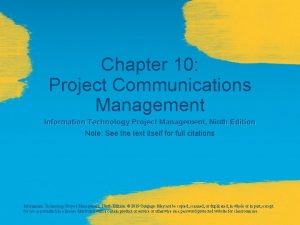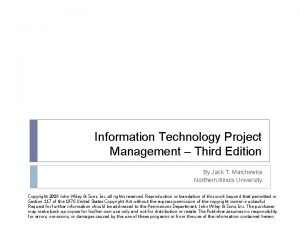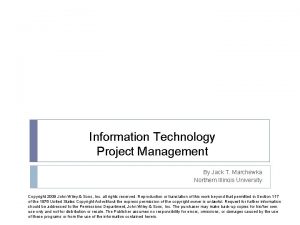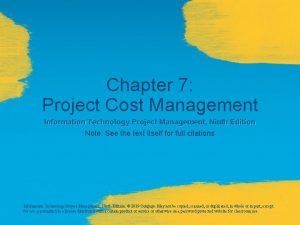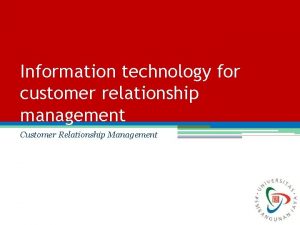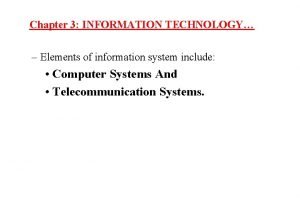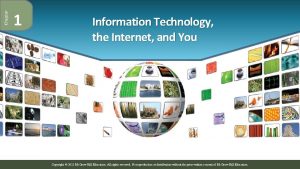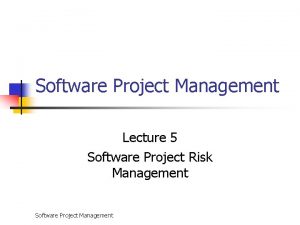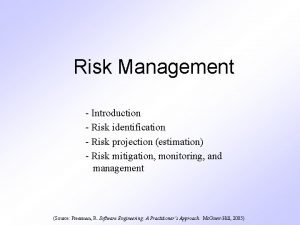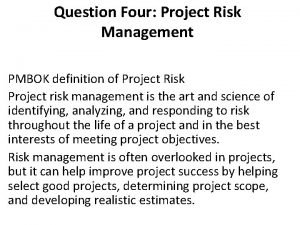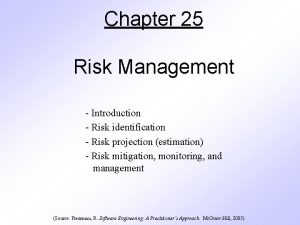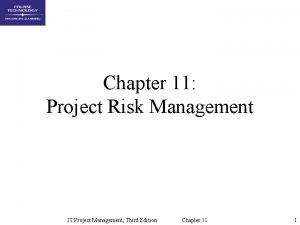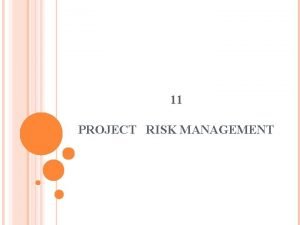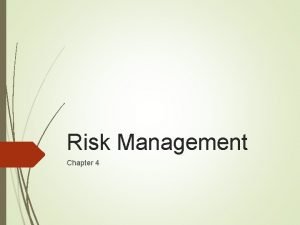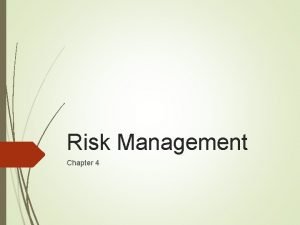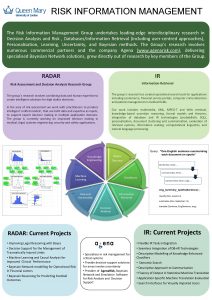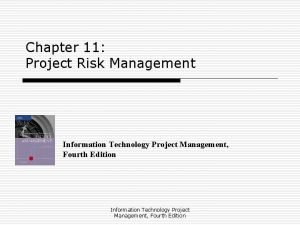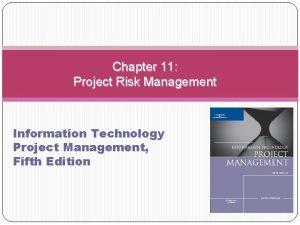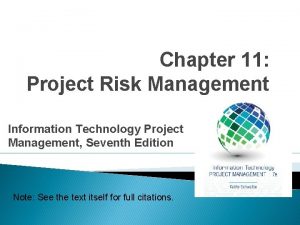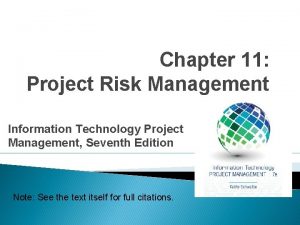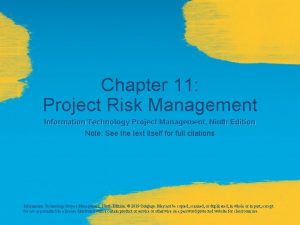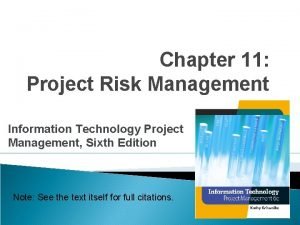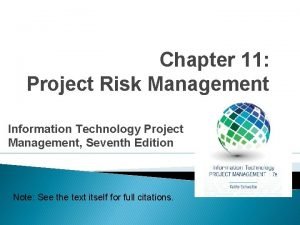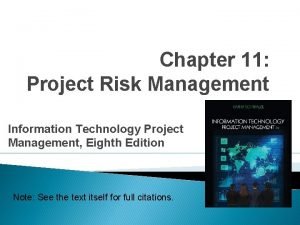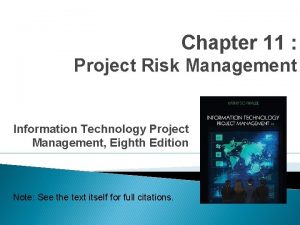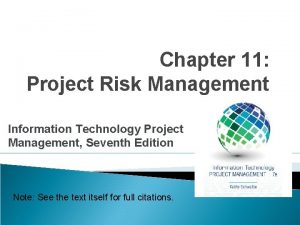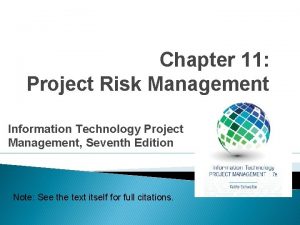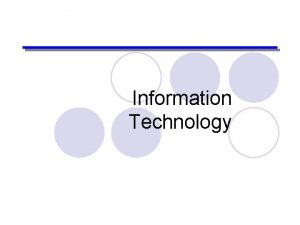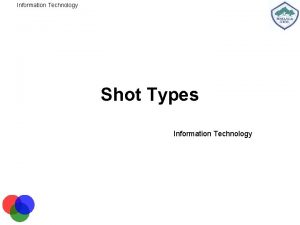Chapter 11 Project Risk Management Information Technology Project

























- Slides: 25

Chapter 11: Project Risk Management Information Technology Project Management, Fourth Edition

Learning Objectives § Understand what risk is and the importance of good project risk management. § Discuss the elements involved in risk management planning and the contents of a risk management plan. § List common sources of risks in information technology projects. Information Technology Project Management, Fourth Edition 2

The Importance of Project Risk Management § Project risk management is the art and science of identifying, analyzing, and responding to risk throughout the life of a project and in the best interests of meeting project objectives. § Risk management is often overlooked in projects, but it can help improve project success by helping select good projects, determining project scope, and developing realistic estimates. Information Technology Project Management, Fourth Edition 3

Negative Risk § A dictionary definition of risk is “the possibility of loss or injury. ” § Negative risk involves understanding potential problems that might occur in the project and how they might impede project success. § Negative risk management is like a form of insurance; it is an investment. Information Technology Project Management, Fourth Edition 4

Risk Can Be Positive § Positive risks are risks that result in good things happening; sometimes called opportunities. § A general definition of project risk is an uncertainty that can have a negative or positive effect on meeting project objectives. § The goal of project risk management is to minimize potential negative risks while maximizing potential positive risks. Information Technology Project Management, Fourth Edition 5

Project Risk Management Processes § Risk management planning: Deciding how to approach and plan the risk management activities for the project. § Risk identification: Determining which risks are likely to affect a project and documenting the characteristics of each. § Qualitative risk analysis: Prioritizing risks based on their probability and impact of occurrence. Information Technology Project Management, Fourth Edition 6

Project Risk Management Processes (cont’d) § Quantitative risk analysis: Numerically estimating the effects of risks on project objectives. § Risk response planning: Taking steps to enhance opportunities and reduce threats to meeting project objectives. § Risk monitoring and control: Monitoring identified and residual risks, identifying new risks, carrying out risk response plans, and evaluating the effectiveness of risk strategies throughout the life of the project. Information Technology Project Management, Fourth Edition 7

Thu 15 -12 Risk Management Planning § The main output of risk management planning is a risk management plan—a plan that documents the procedures for managing risk throughout a project. § The project team should review project documents and understand the organization’s and the sponsor’s approaches to risk. § The level of detail will vary with the needs of the project. Information Technology Project Management, Fourth Edition 8

Table 11 -2. Topics Addressed in a Risk Management Plan § Methodology tools § Roles and responsibilities § Budget and schedule § Risk categories § Risk probability and impact § Risk documentation - formats Information Technology Project Management, Fourth Edition 9

Broad Categories of Risk § Market risk – is IT product useful? § Financial risk – affordable? Available resources? § Technology risk – HW, SW, network … available? § People risk – people to complete the project? § Structure/process risk –what changes will it introduce? Interaction with other systems? Information Technology Project Management, Fourth Edition 10

Risk Identification § Risk identification is the process of understanding what potential events might hurt or enhance a particular project. § Risk identification tools and techniques include: § Brainstorming § Interviewing § SWOT analysis Information Technology Project Management, Fourth Edition 11

Brainstorming § Brainstorming is a technique by which a group attempts to generate ideas or find a solution for a specific problem by amassing ideas spontaneously and without judgment. § An experienced facilitator should run the brainstorming session. § Be careful not to overuse or misuse brainstorming. § Psychology literature shows that individuals produce a greater number of ideas working alone than they do through brainstorming in small, face-to-face groups. § Group effects often inhibit idea generation. Information Technology Project Management, Fourth Edition 12

Interviewing § Interviewing is a fact-finding technique for collecting information in face-to-face, phone, e-mail, or instantmessaging discussions. § Interviewing people with similar project experience is an important tool for identifying potential risks. Information Technology Project Management, Fourth Edition 13

SWOT Analysis § SWOT analysis (strengths, weaknesses, opportunities, and threats) can also be used during risk identification. § Helps identify the broad negative and positive risks that apply to a project. Information Technology Project Management, Fourth Edition 14

Qualitative Risk Analysis § Assess the likelihood and impact of identified risks to determine their magnitude and priority. § One of the most important risk quantification tools and techniques is the Probability/impact matrixes Information Technology Project Management, Fourth Edition 15

Probability/Impact Matrix § A probability/impact matrix or chart lists the relative probability of a risk occurring on one side of a matrix or axis on a chart and the relative impact of the risk occurring on the other. § List the risks and then label each one as high, medium, or low in terms of its probability of occurrence and its impact if it did occur. § Can also calculate risk factors: § Numbers that represent the overall risk of specific events based on their probability of occurring and the consequences to the project if they do occur. § Ex: HW – old, complex, no support Information Technology Project Management, Fourth Edition 16

Figure 11 -4. Sample Probability/Impact Matrix Information Technology Project Management, Fourth Edition 17

Table 11 -6. Sample Probability/Impact Matrix for Qualitative Risk Assessment Information Technology Project Management, Fourth Edition 18

Quantitative Risk Analysis § Often follows qualitative risk analysis, but both can be done together. § Large, complex projects involving leading edge technologies often require extensive quantitative risk analysis. § One of the main techniques is Decision tree analysis Information Technology Project Management, Fourth Edition 19

Decision Trees and Expected Monetary Value (EMV) § A decision tree is a diagramming analysis technique used to help select the best course of action in situations in which future outcomes are uncertain. § Estimated monetary value (EMV) is the product of a risk event probability and the risk event’s monetary value. § You can draw a decision tree to help find the EMV. § Ex: which project to submit a proposal? 1, 2, both or none? Information Technology Project Management, Fourth Edition 20

Figure 11 -6. Expected Monetary Value (EMV) Example Information Technology Project Management, Fourth Edition 21

Risk Response Planning § After identifying and quantifying risks, you must decide how to respond to them. § Four main response strategies for negative risks: § Risk avoidance (eliminating) – continue using the same HW, SW § Risk acceptance – contingency plan, backup § Risk transference (shifting) - insurance for HW § Risk mitigation (reducing) – competent personnel, maintenance agreement Information Technology Project Management, Fourth Edition 22

Response Strategies for Positive Risks § Risk exploitation – fund computers to school, make news coverage, this will lead to more business. § Risk sharing – same example, but share news coverage with school’s board, and make partnership for training teachers on how to use PCs. § Risk enhancement – changing the size of an opportunity by using drivers. Get good public relations with students, teachers, parents. Then they will make ads for project. § Risk acceptance – do nothing, just assume the project will result in good public relation. Information Technology Project Management, Fourth Edition 23

Residual and Secondary Risks § It’s also important to identify residual and secondary risks. § Residual risks are risks that remain after all of the response strategies have been implemented. § New and stable HW bought may fail § Secondary risks are a direct result of implementing a risk response. § New and stable HW bought caused other peripheral devices to work improperly. Information Technology Project Management, Fourth Edition 24

Risk Monitoring and Control § Involves executing the risk management process to respond to risk events. § Workarounds are unplanned responses to risk events that must be done when there are no contingency plans. § Main outputs of risk monitoring and control are: § Requested changes. § Recommended corrective and preventive actions. § Updates to the risk register, project management plan, and organizational process assets. Information Technology Project Management, Fourth Edition 25
 Market risk credit risk operational risk
Market risk credit risk operational risk Information technology project management 9th edition
Information technology project management 9th edition Blue project chapter 5
Blue project chapter 5 Project management quality control
Project management quality control Project management chapter 6
Project management chapter 6 Information technology project management 9th edition
Information technology project management 9th edition Information technology project management
Information technology project management Information technology project management
Information technology project management Key risk indicators template
Key risk indicators template Risk map
Risk map Introduction to software project management
Introduction to software project management Information technology cost management
Information technology cost management Enterprise and global management
Enterprise and global management Managing information technology resources
Managing information technology resources Information technology and customer relationship management
Information technology and customer relationship management Information technology chapter 3
Information technology chapter 3 Chapter 1 information technology the internet and you
Chapter 1 information technology the internet and you Chapter 1 information technology the internet and you
Chapter 1 information technology the internet and you What is risk in software project management
What is risk in software project management What is risk projection
What is risk projection Pmi risk management definition
Pmi risk management definition Risk mitigation techniques in project management
Risk mitigation techniques in project management Rmmm table
Rmmm table Top ten risk item tracking
Top ten risk item tracking Project risk management adalah
Project risk management adalah Wv board of risk and insurance management
Wv board of risk and insurance management





